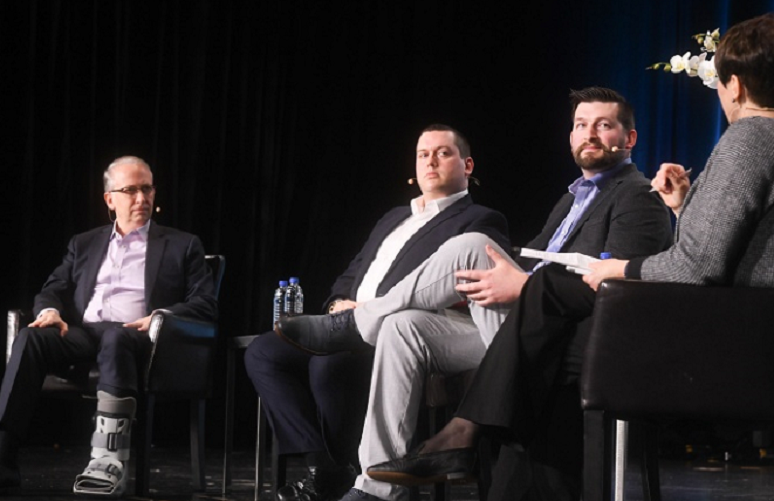Along with the move to the cloud, communications and collaboration technologies are becoming increasingly software-centric and open for customization and integration. Deployment implications aside, the shift ushers in the need for an organizational rethink -- silos be gone and long live the multidisciplinary team with a developer-orientation and innovation mandate.
Mortgage lender-turned-technology company Quicken Loans has been quick to adapt to the developer-focused future -- the topic of an
enterprise IT panel at the recent Enterprise Connect 2019 event. “Innovation is absolutely a key component to our approach to the market and how we drive the industry … so the developer-focused culture for us is absolutely critical to how we succeed,” shared
Benn Wolfe, technology lead for communications at the company, during the panel discussion.
Part and parcel of establishing the developer-focused culture at Quicken Loans has been adoption of an Agile methodology for software development, the underpinning of which is the cross-functional team, Wolfe said. “You can always do better and have more cross-functional teams; you can have more people who are empowered to solve problems and own them from inception to completion. … That's one of the things I really spent a lot of time working out with Quicken Loans, and Quicken Loans empowers all of its leaders to make sure that we're delivering that message to our teams,” he added.
If Wolfe makes this sound easy, it’s not, as our other panelists pointed out.
For one, achieving balance between the old and new can be tough, said
Carmine Lizza, CIO at Lazard, a global financial advisory and asset management firm. Lazard, no doubt, is not alone in being at an inflection point, which Lizza described as the need to continue running a global organization on “legacy” systems while also being forward-looking enough to attract -- and retain -- people who understand and can develop in cloud environments such as Microsoft Azure and Amazon Web Services.
As important as application development has been and will continue to be, “app dev is pointless without the infrastructure -- and I think the healthiest organizations bring those together,” Lizza added.
Balance and talent acquisition are likewise a challenge at Marine Rescue Technologies (MRT), a safety systems manufacturer, agreed
Darryl Jackman, a business automation developer at the company. The move to a cloud platform triggered paradigm shifts in logistics and hiring at MRT, he noted. Once the company moved to an API-based cloud platform “it opened the doors for what we could do very differently compared to being just on premises systems,” Jackman said. And that has led to the challenge of “finding the right people who are openminded and on top of leading technologies.”
What constitutes the right sort of person for the developer-focused future? What skills are requisite for the multidisciplinary team guiding the way? How does this look from an IT cultural standpoint? Wolfe, Lizza, and Jackman shared some ideas during the panel discussion, including these six.
1. Include enterprise architects and tech-savvy business product managers on the team. These are “two sides of the same coin,” Quicken Loans’s Wolfe said. As part of a service-oriented architecture strategy, enterprise architects will know which information and tools they need to solve problems quickly. And product managers who have a basic understanding of technology can help translate business needs so the team can identify the microservices that will solve their problems, he said.
2. Ensure your technologists know the business. Absent business knowledge, technology can get done for technology’s sake alone, Lizza warned. One way he assures this doesn’t happen at Lazard is taking technology team members from cubicle to cubicle -- “’let’s go meet with some other people in our organization,’ I tell them,” Lizza said. They need to get out of their technology comfort zones in order to understand the business end goal, he added.
Quicken Loans addresses this issue by having all technology hires go through a “Passport to the Business” program within six months of joining the company, Wolfe said. “This is an organized program where you go systematically through every single piece of the business, from origination through servicing -- everything -- and that just pays us huge dividends down the road when your first opportunity is to understand the top-to-bottom picture.”
3. Don’t isolate developers and engineers from the end customers. Just as important as knowing the business is knowing the customer, Jackman said. “MRT will sometimes get [developers and engineers] on the sidelines of customer opportunities … so they can be among the people and see the excitement around a solution,” he explained. The company finds this motivates the developers to think outside the box and causes them to want to make customers just as happy and excited as they are. “We found it works really well to get people to feel like they’re involved,” Jackman said.
4. Don’t forget to incorporate security expertise when moving ahead with a developer focus. This is particularly sensitive for Lizza, given the nature of Lazard’s business, but it’s a widespread challenge, particularly when casting a wide net to catch your developer talent. At Lazard, for example, “we’ve got a lot of people who we brought in from outside of financial services, from startups in many cases, who… it's not that they don't consider security, but it's not a paramount focus,” Lizza said. But security must be front of mind all the time, so educating his team about secure development best practices – DevSecOps -- is an imperative. Having the chief information security officer participate on a project goes a long way in assuring the appropriate thought goes into security, as well, he added.
The security mindset is critical at MRT, too, Jackman agreed. “With today’s climate, especially going from premises to cloud, security should be first and foremost.”
5. Remove barriers to progress. One downside of development work can be the “we’re done with our piece but waiting on that group to finish its work” attitude, Lizza said. That’s something he’s seen cropping up at Lazard, so much so, he said, that he has a running joke with his team that he’s going to steal the idea of a swear jar. Just like people have to toss a buck into a swear jar upon uttering a curse, he said he’d like to make team members do the same using a “blocker jar” when they talk about having to wait on somebody else to wrap up a project. This type of excuse “gets thrown out a lot in the industry now, [and I don’t like it.]”
At Quicken Loans, having cross-functional teams has helped alleviate this sort of problem, Wolfe said. “To the extent that we can keep all the work centralized inside of the team, we can really kind of continue [work on a project] -- there's nowhere to hide, you have to understand and know that you have to get it all the way to the finish line.”
6. Invest in your people. Do so, and you’re sure to keep them engaged, Wolfe said. “Take the time to present new opportunities to your existing people. I do believe that they will jump up and take the reins if given the opportunity,” he added. At Quicken Loans, this manifests itself in a “relaunch program” that lets people sign up for new learning opportunities and shadowing on different teams.
Here’s the upshot from Lizza on how any enterprise IT professional should be thinking about how to take a developer-focused mindset and empower their organization for the future: Don’t be afraid to be a thought leader. “If you work in an organization where someone is going to penalize you for trying something different, you're probably not in a good organization.”
Click on the video player below to hear the full panel discussion.










